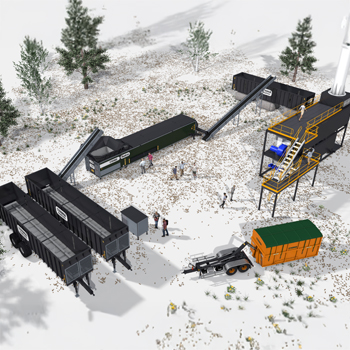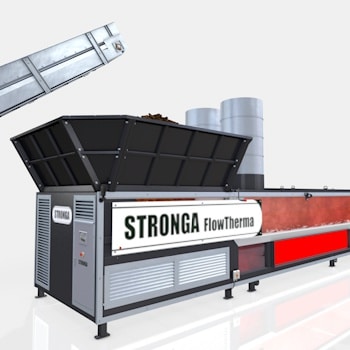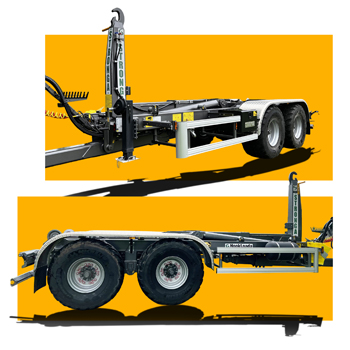As you can see from the photo below which was taken in the Bohemian Forest Mountain range in Germany, bark beetle infestation can have devastating environmental impacts. This article sets out the arguments for drying and repurposing infected wood in order to minimise spread and wastage while providing useful added income for forest land owners.

What is the Bark Beetle?
There are many different species of bark beetles; each has contrasting impacts on different woodland areas. The European bark beetle is known as the ‘spruce bark beetle’ (Ips typographus) and this species predominantly causes damage to spruce and pine trees. Other species include the ‘mountain pine beetle’ (Dendroctonus ponderosae) and the ‘great spruce bark beetle’ (Dendroctonus micans).
All species of bark beetle are highly reproductive and can have a life cycle of 12-18 months. They burrow into tree bark where they lay eggs in ‘galleries’. Larvae from these eggs feeds on the internal trunk wood layers, which reduces the nutrients and disrupts the tree’s flow of water, in some cases leaving the tree with only a 20% survival chance. Female bark beetles can generate as many as 300 eggs – leading to a population explosion which causes catastrophic destruction to forests.

Increasing Outbreaks Across Europe
The chart below shows that in 2019, 20.7 million m3 of harvested spruce wood infested by bark beetle was registered in Czech Republic, which represents an increase of more than 70% compared with 2018 when approximately 12 million m3 was recorded. The massive spruce infestation with bark beetles has been triggered by higher average temperatures and lower precipitation. This is the case in Czech Republic and across Europe, too.
Despite management strategies being put in place to reduce future devastation – there is still a surplus of damaged wood which needs clearing. Stronga’s drying and transport equipment provides an excellent solution for ‘disposing’ of infected wood in accordance with industry standards, aimed at minimising further spread and costly wastage.

What is the Bark Beetle’s Effect on the Timber Industry?
Despite there now being an improved understanding of bark beetle infestations, along with better management and biological strategies, forestry damage has already been done and continues to occur. The timber industry has felt the damage more than others, especially in many European countries where wood is still used for fuel and construction purposes. Roundwood and lumber prices have increased as a result of reduced availability, with some wood becoming undesirable as a result of bark beetle fungus discolouration.
The graph below indicates there is a significant amount of damaged wood from bark beetle infestation in Germany, Czech Republic and Austria, with numbers peaking in 2021 but remaining high throughout the start of 2024.

At Stronga, we encourage forest owners to consider the high value of the ‘damaged’ wood left to decompose on the forest floor, which encourages further spread of pests like the bark beetle. One potential avenue to utilise infected wood is to dry it and input it into a modular reactor to produce biochar or bio-energy via pyrolysis or gasification. Using Stronga’s HookLoada trailer and modular drying system - FlowDrya, forestry owners have the chance to repurpose bark beetle infested wood, creating new environmental stability and prosperity, whilst also, enabling positive economic outcomes.
Countless acres of forestry have been lost due to the bark beetle epidemic; millions of trees have already been destroyed and these damaged trees populate forests all over the world. Stronga offer solutions to counteract a globally significant issue. Read on to learn more.

Harz Forest – Germany’s Beloved National Park, Destroyed by Bark Beetle
One particular forest which has been targeted by bark beetle pests in recent years is Harz Forest; a beloved tourist attraction in Germany. Recent reports suggest that roughly 40% of woodland in the Harz Forest region has been lost between 2001-2021. Less tree cover, more soil damage, warmer temperatures/droughts and increased bark beetle activity has been attributed to the huge amounts of damaged timber and significant economic issues for the region.
It is important to observe maintenance strategies which aid in ‘future-proofing’ valuable timber resources and ensure economic and environmental stability for future generations. This includes adopted ecological strategies to utilise bark beetle infected trees. Stronga proposes that chipping, drying and biochar production is one useful solution to achieving long-term prosperity in difficult circumstances.

The Harz region is separated into ‘dynamic’ and ‘development’ zones. The ‘dynamic zone’ allows nature to regenerate itself and develop without human interference. Damaged trees are left to break down and decompose on the forest floor. While this is a good initiative, it takes a very long time to display any kind of positive outcome.
Stronga’s solutions aid the mitigation of losses as a result of bark beetle destruction, particularly in the ‘development’ part of the forest, which relies on human assistance for development. The trees in this area (as well as from other damaged forests) can be harvested, chipped, dried and conditioned before being input into a gasifier or pyrolysis reactor for bio-energy or biochar production. This process can be done locally; utilising modular containerised Stronga equipment to reduce risks of further spread. Biochar material produced from the pyrolysis process can be redistributed in the Harz zone to encourage woodland re-growth, capturing carbon while encouraging tourism to thrive in the region, once again.

Protecting the Future of Our Forests
To support the forest cycle, weak trees and those that are classified as ‘at risk’ of bark beetle attack must be removed to limit further destruction, allowing forestry owners to establish control over the land. This helps reduce bark beetle populations and increases rapid re-growth opportunities in desolate forests.
With the huge surplus of readily-available damaged trees in Harz Forest and beyond, Stronga collaborate with those willing to take a step towards dry woodchip, biochar and energy production. Stronga’s FlowDrya is able to condition and dry woody biomass to accelerate positive re-greening in forests. Stronga equipment can be utilised in several ways:
1. Timber is harvested, cut and stripped in the forest.
2. Harvested timber is loaded onto the versatile HookLoada trailer via your preferred method: (1) chipped into containers ground-demounted on the forest floor; (2) chipped direct into trailer-mounted container; (3) roundwood loaded directly onto a bolstered flatbed via an integrated crane.

3. If roundwood is loaded onto the flatbed, it is then transported for sawing. Useful wood is separated and treated and the remaining woody by-product (including brash) is chipped for biochar or wood fuel production.
4. Back at the drying plant, woodchip delivered by the HookLoada is conveyed directly into the FlowDrya hopper where it can then be dried to the optimal moisture content for the biochar reactor. The modular nature of Stronga equipment enables handling and drying processes to be carried out close to the infection site which is important in reducing the risk of further transmission. This is vital because there are movement restrictions in place for dealing with bark beetle infected wood.

5. Dry woodchip from the FlowDrya is input into a pyrolysis reactor or gasifier which ensures any trace of bark beetle is destroyed. The output from pyrolysis or gasification is high quality biochar output and renewable energy production.
6. If required, Stronga’s FlowFeeda woodchip feeding equipment (shown below) can act as a handy buffer store for delivering chip to the pyrolysis reactor or wood gasifier.
7. Overall, this process removes infected trees from forests, therefore reducing spread risks while providing forestry owners with the chance to regenerate land with valuable biochar output. Biochar is transformative for arid soils by increasing water retention which is especially necessary for forestry with less tree cover, that continue to be affected by droughts. Biochar also encourages quicker microbial activity, soil bio-diversity and vegetation growth.

“Re-Green” with Pyrolysis or Gasification
Dry woodchip is a valuable resource which can be input into pyrolysis reactors or gasifiers for biochar and energy production (via CHP). Biochar can be used to aid in ‘re-greening’ forests while optimising future tree growth by enriching low carbon soil. Biochar is a far quicker process than the natural decomposition cycle of an infected tree which eventually releases its microbes into the soil.
Repurposing infected trees through drying and pyrolysis/gasification converts them into rich, organic soil improvers, paving the way towards a better environmental future. Not only does biochar offer environmental benefits, the producers are also provided with a valuable asset and ‘carbon credit’ revenue opportunities.

Architects of Renewal
Stronga’s HookLoada trailer and FlowDrya are long-life investments, built by experienced craftsmen using the highest quality materials. See below the key features of each product:
- HookLoada is able to efficiently ground-demount containers which makes loading timber more efficient, reducing associated handling costs.
- Stronga hook lift trailers are built using ultra-light, extra-strong Hardox steel which is proven to last in tough forestry environments.
- Stronga hook lift equipment has tremendous lifting and tipping power, reducing loading cycles, labour hours and fuel usage with their associated costs.
- HookLoada has a super-low chassis. A lower centre of gravity, compared to other hook-lift equipment, means HookLoada is highly stable and can be easily loaded with timber products, container-mounted or demounted.

FlowDrya - Modular Woodchip Drying Solutions
- FlowDrya is able to accept residual energy from pyrolysis, gasification and ‘GenSets’ – limiting additional energy costs.
- Fitted with a large infeed hopper, FlowDrya can accept large amounts of biomass input, reducing refilling frequency and associated labour costs.
- PulseWave™ agitation on the woodchip drying bed ensures all input material is dried, uniformly and consistently.
- FlowDrya equipment features unique ‘stop-start’ operation. The machine sleeps in-between floor strokes, limiting wear and tear on key components.
- FlowDrya is well insulated all-around, minimising energy losses from the dryer.
- Low temperature, in-direct air system minimises the risk of fire.

Although measures are in place to reduce further destruction from bark beetle outbreaks, there are already millions of damaged trees that need ‘recycling’. Stronga’s proposal not only re-purposes destroyed trees, but drying and pyrolysis/gasification will also speed up the entire forest rejuvenation process.
Collaborating with Stronga gives you access to decades worth of practical experience and knowledge; enquire today to learn more about our hook lift equipment and woodchip drying solutions - info@stronga.co.uk



Share this post